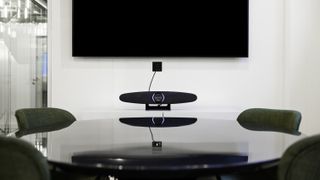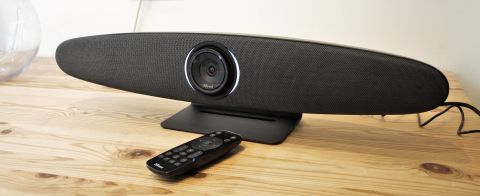TechRadar Verdict
The Trust Iris provides high-quality images and sound that corporate users demand and at a price they’ll like. Control freaks will be annoyed they can’t remotely direct it, but in all other respects, this is an excellent piece of gear.
Pros
- +
Driverless
- +
Competitively priced
- +
HDR mode
Cons
- -
Lacks remote management
Why you can trust TechRadar
(Note: Until July 24th, you can buy the Iris conference camera for only £599 at Amazon)
Trust has been making digital cameras from the outset of that technology and has a proven track record of boiling down products to the features people genuinely want, ignoring those that are rarely used.
These days it makes a wide range of PC related technology alongside audio, phone, gaming and smart home devices and has recently embraced business conferencing.
Its first product in this sector is the Iris, a meeting room audio and video solution to deliver high-quality communications to those meeting digitally.
For Trust, this is one of the more expensive items they make, but for the corporate world, the Iris looks like it might be a bargain.
Price and availability
The Trust IRIS 4K Ultra High Definition Conference Camera, as described on Amazon, costs £719 from that online retailer in the UK and €799 in Europe.
It should be available across a range of popular retail outlets, at a similar price soon.
Four accessories are made by Trust to support its device; an extension microphone (€129), a 10m USB cable (€99), a 15m optical USB cable (€249) and a VESA TV mount (€ 69).
Due to some complication that we can’t explain, this product is solely intended for sale outside the US.

Design
It’s hard to say why, but the Iris has the sort of design that we’d expect to see in a corporate context. Smooth curved lines with a combination of black and dark grey elements impart a stylish yet professional aesthetic.
This device was designed to sit at the end of a conference table or on a supporting table and provide a wide view of those assembled. Trust provides the Iris with a wall mount in the box, and as an optional accessory, they also have a TV mounting solution.
The viewing angle of the camera is 120 degrees, enabling it to see most attendees that are in front of it but not directly at the sides.
For it to function, his hardware must be connected to a computer by USB, and a three-metre is included with a Type-A connector at the computer end and a Type-C at the other to attach to the Iris.
While 3m might seem a decent length, Trust also makes an extended 10m version should you have a Dr. Evil scale boardroom table and a stubborn chairman who won’t move from the end of it. Or, if he won’t even leave his office, a 15m ‘optical’ USB cable is also an option.
The final optional accessory to the extended cable is an extended microphone with a 10m range from the Iris to make audible those that like to nap through the sales and marketing presentations.
The TV mount, extension cables and extended microphone are not yet on sale, but they should be available shortly.
What you do get included is a small 24W power supply, avoiding the need for the USB to power the device, even if this might have been possible.
As it is likely that the connected PC might be a laptop and therefore battery-powered, having a dedicated PSU has some understandable advantages.

It also comes with a small remote control that can make rapid adjustments to the direction of view, audio and brightness levels and the attendee that has focus. The remote is very useful, but we’d be concerned that this is the one part of the Iris package that could easily be misplaced, making it much less convenient.
The only other reservation we have about the Iris so far is that the lens has no cover to avoid dust collecting on it and to categorically prove that it isn’t in use. But, we’ll cover privacy in more detail in the next section.
Overall, the look of the Iris and the quality of construction is top-notch, but conference cameras often fail on how easy they are to use, so is this the weakness of this design?

In Use
It is interesting to note that there are some similarities in the approach that Trust has taken in common with other conference camera makers. Iris is a software-devoid solution where control is partly conceded to the device, and it isn’t mandatory that someone must play video editor at the proceedings.
Unlike the Coolpo Huddle that we covered recently, the Trust Iris isn’t entirely automatic as it can be overridden by the remote, but intervention is a choice here.
Because the Iris doesn’t need a software install, it works with all the meeting software we tested, like Zoom, Skype, Google Meetings, Microsoft Teams, etc.
In all of these scenarios, the camera and microphone appear as available devices once Iris is attached by USB, and the person hosting the meeting can enable and disable these inputs as required.
The automatic aspect of this design kicks in once the meeting starts, and the system will show a light around the camera lens to indicate that the camera is on. Muting the video or audio alters the colour of this illumination to show this status and avoid people embarrassing themselves with remote colleagues.
By default, the full quality of the Sony sensor camera delivers a 4K (3840x2160) 60fps image of the whole scene, which should make everyone recognisable around the table.
A quick press of the remote can send the system into audio mode, where the camera will take instructions from the directional microphones as to who is speaking and centre on them.
Those with a recollection of 1960s science fiction movies might find this a bit HAL900, but it works seamlessly in most situations. Once the system is in the desired mode, it doesn’t require constant attention, allowing the meeting to proceed naturally.

One feature we especially liked is that the camera has an HDR mode. This methodology takes multiple images at different exposures and combines them to bring details out of the shadows and avoid overexposed sections of the image from blowing-out.
Many conference rooms aren’t uniformly lit, and HDR mode works well to address the classic mistakes where attendees are silhouetted against a bright window or hidden in the shadows.
The camera has logic that identifies faces and can move between them. But if you have something else you want to present, like a new product, then the camera can be directly controlled from the remote, and five levels of digital zoom are also available to get closer.
Optical zoom would have been preferable over digital, but with a 4K sensor, the results aren’t excessively blocky.
If you find that you constantly adjust the camera to a particular view, the remote can also store two preset views that can be recalled in a single button press when needed.
Competitors
Trust isn’t the only maker of a sound-bar style conferencing solution, but the Iris is one of the cheapest at just £719 ( €799).
Logitech has the similarly specified Meetup for €1099, Poly the Studio at €1,041 and Jabra the Panacast costing €806.
It’s worth noting that the Logitech Meetup has software remote mode, but that using it requires coordinated installations. The Poly Studio has a fixed lens but can be connected to the host system using WiFi.
And, the Jabra Panacast is purely a camera, has three lenses allowing for a panoramic view with 180 degrees of vision. To add speakers requires an additional Hub to be bought, and the microphone pick up range is only 2.5 meters.
These are the leading contenders, but given the current explosion in conferencing, we’d expect to see more of these solutions in the coming months.

Final verdict
The Trust Iris is a well-considered solution that provides 95% of the functionality that most conferencing rooms require that aren’t for ultra-secret meetings and are to be organised by ordinary employees, not technology gurus.
It only misses one feature that some customers like, and that’s the ability of the remote viewers to control the camera. To achieve this would require software to be installed at both ends, ruining the plug-and-play simplicity of this design.
Imagine you’ve set up a meeting with senior people at another office, and during the meeting, a problematic question gets asked. Typically, the question poser will then remotely take over the camera and zoom in on the person they think needs to address that issue, putting them under even more pressure.
But, and this might be a good thing, only those local to the Iris can pick out a non-speaking participant and not anyone at the other end of the call.
Alternative products, like the Logitech Meetup, have this feature, but they require software to be installed to facilitate this functionality.
We’re not convinced either way, but the simplicity of a design that doesn’t require software to be installed and maintained to make this solution work is beginning to sway us to the Trust Iris approach.
Even if it doesn’t offer the ultimate control, the value of that functionality is at best debatable and getting conferences to happen smoothly and without technical issues is surely paramount?
The Trust Iris can deliver exactly that and at an affordable price.
Mark is an expert on 3D printers, drones and phones. He also covers storage, including SSDs, NAS drives and portable hard drives. He started writing in 1986 and has contributed to MicroMart, PC Format, 3D World, among others.


